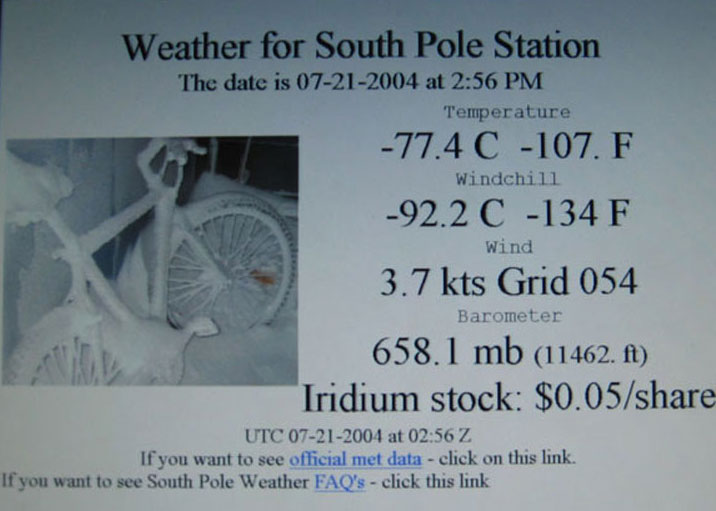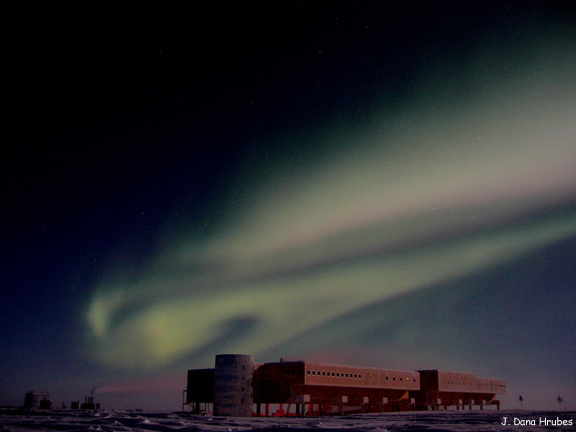July, 2004....J.
Dana Hrubes...updated July 31, 2004 , 0717 GMT
(CLICK ON UNDERLINED LINKS FOR PHOTOS....CLICK
"BACK" ON YOUR BROWSER TO RETURN TO THIS PAGE)

The
local weather watcher shortly before the temperature dropped to -107.9
o F, the record so far this winter.
Just days earlier we missed reaching the all time low barometric
pressure of 641.7 mbar by only 0.7 mbar
bringing us to an equivalent altitude of over 12,100 feet.
July at the Pole - dark and cold
July
brought us the coldest temperatures and lowest barometric pressures of
the year so far. We broke the all time record for the coldest average
temperature for the month of July with -88.4o F (-66.9o C). The low
temperature so far this year of -107.9o F was on
July 21st and
we almost broke the all time low barometric pressure of 641.7
millibars a few days earlier. At that pressure we were essentially
living at an equivalent
elevation of about 12, 100 feet making it a bit difficult to breathe
while exerting yourself.
Some of us are hoping to break more records in August, historically the
coldest month of the year. We have dropped below -100o F ten days this
year so far, giving the winterovers here ample opportunity to join the
300 club. To join the 300 club, you must wait until the temperature
outside is below -100o F and then we turn
the upper berthing sauna up
past +200o F and we sit in the
sauna until we can't stand it anymore. At
that point wearing nothing but boots and a smile we run out of upper
berthing down the dome tunnel through the dome door, climb up the 35
foot drift to the polar plateau and then to the geographic pole and
back. 300
club patch
Between
periods of extremely cold weather, the winds will increase and the
temperatures will rise into the -80's and sometimes into the -70's .
This is when you see the heavy equipment operators furiously trying to
get work done that has been piling up. Generally there is no vehicle
activity with the caterpillars below -80 F because of temperature
related equipment failures. During this time I am usually shoveling
drifted snow out of my back door on the first floor lab of skylab in an
attempt to keep the door accessible. outdoor access to
skylab with stairs cut out of the drifted snow
Meanwhile meteorology department continues with daily
weather balloon launches no matter what temperature we are
experiencing. balloon launch
(photo by Kris Perry)
I have
had to do outside work on the SETI telescope as well as many of my
other
projects frequently this winter.
This type of work outside has similarities to working extravehicular
activity on science hardware in space. You have extremely bulky
protective clothing making everything you do take many times longer,
the environment is extremely hostile and unforgiving, visibility is
poor, exposure time of sensitive components and your body is limited,
mistakes cannot be tolerated, and maintaining sufficient manual
dexterity is difficult. The telescope is mounted on the 35 foot high
telescope tower exposed to
the winds. Working on the telescope, particularly when opening up
heated components at these extreme temperatures, requires hours of
preparation. This preparation is necessary because once the heated
telescope interior is opened and exposed to temperatures down to -100
F, you only have minutes to complete your work before you must close
the unit so the electronic components will not get too cold and fail.
In
addition, when working on these delicate components you must wear thin
polypropylene gloves to get the necessary dexterity. This gives you
only
minutes to work before your fingers begin to freeze. In these
situations it is impossible to avoid some frostnip.... the trick is to
know your limitations and to keep it to a minimum. leaving the meteorology
office to walk to the SETI tower (you need to bring all equipment you
need and might need because time is crucial when components and your
fingers are exposed to the extreme cold and wind)
the SETI/AASTO telescope tower
with small blanket windbreak set up ready to perform work
working on the
telescope at -95 F
working on the
telescope
SETI telescope tower and
service building backlit by the star field of the Southern hemisphere

Aurora Australis over the new South
Pole Station illuminated by the full moon on July 2
(it was the highest full moon of the season at 26o 30')
Once
again, we experienced many breathtaking auroras this month.
Some were taken during the two weeks the moon was up and some were
taken during the moonless, extremely dark periods.
These photos are time exposures; therefore, in the moonlit
photos, objects appear brighter than they really are.
big
aurora over skylab (no moon)
Atmospheric Research
Observatory with the atmospheric turbulence LIDAR laser beam in the
near horizontal position (no moon)
aurora over the
moonlit new station
aurora over the SETI
telescope (no moon) SETI aurora (no moon)
aurora
over moonlit skylab and dome aurora over moonlit
skylab
aurora over the moonlit VLF
transmitter building
The
construction of the new station is proceeding
rapidly. hallway second floor
new galley
kitchen
For photos of the inside of the old dome and the buildings, etc. see my
web site for the year 2000-2001. home page The May entry has
quite a few photos, but the other months also show photos of the old
dome.
Since
there is no food service on Sundays volunteers frequently cook
for the station crew. Last Sunday four of us made a sushi dinner for
the station. There was no raw fish here, but we used things like fake
crab meat, canned mackerel, tuna, cucumbers from the greenhouse,
etc. sushi
making serving the crew
We had
no gigs planned for the South Pole band this month we just
practiced new songs bringing our total song list to over 30. Our next
gig is August 21st. band after practice in
the skylab lounge This is the time of
year when people who are not cutting their hair (like myself) are
getting a bit ragged July hair
NEXT MONTH: the
coldest month and the beginning of astronomical twilight.....
A Real-Time Photo of South Pole Station as Seen from the ARO
Building (live when satellite is up)
A Comprehensive
South Pole Web Site by Bill Spindler
Winterover Web Pages
(Bill Spindler's List)
SOUTH
POLE 2003-2004 HOME PAGE

